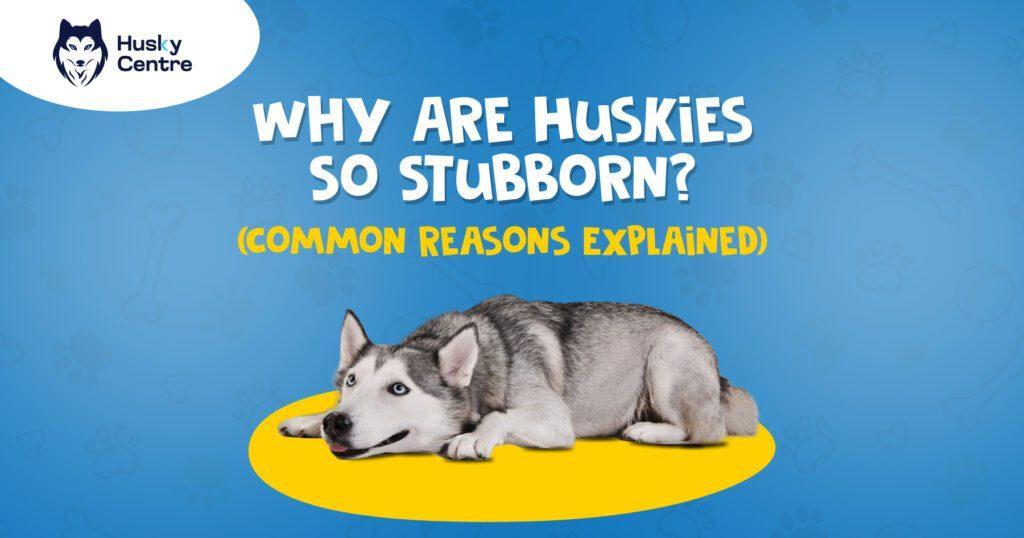A Husky’s tail position can reveal much about its emotions and health. If your Husky’s tail is always down, it might be a sign of various issues.
Understanding why your Husky’s tail stays down is crucial. It could be due to emotional distress, physical pain, or even health problems. Huskies are known for their expressive tails, so a drooping tail can be a cause for concern. Observing your pet’s overall behavior can provide clues.
This introduction will explore the possible reasons behind this behavior, helping you ensure your furry friend stays happy and healthy. Let’s dive into the common causes and what you can do to help your Husky regain its lively tail posture.
Reasons For A Husky’s Tail Position
Understanding why your Husky’s tail is always down can be puzzling. There are several reasons for a Husky’s tail position. This can range from natural posture and breed-specific traits to emotional states. Knowing these reasons helps in understanding your dog’s behavior better.
Natural Posture And Breed-specific Traits
Husky tail posture is often influenced by their breed-specific traits. Huskies have a unique tail structure. Their tails are thick and bushy, often referred to as a “sickle tail.” This shape is common among sled dog breeds.
Here are some key points about their natural posture:
- Genetic traits: Huskies have a natural tendency to hold their tails down or in a relaxed position. This is part of their genetic makeup.
- Temperature regulation: When it’s warm, Huskies may keep their tails down to avoid overheating. Their bushy tails can trap heat.
- Energy conservation: Keeping the tail down can be a way to conserve energy. It’s a relaxed posture that doesn’t require much effort.
In summary, a Husky’s tail position can often be attributed to their natural and breed-specific traits. Understanding these helps in interpreting their body language better.
Reflects Emotional States
Husky emotional signals can be observed through their tail position. Dog body language tail positions can indicate various emotions.
Consider these emotional signals your Husky might be showing:
| Tail Position | Emotional State |
| Tail down and relaxed | Calm or neutral |
| Tail tucked between legs | Fearful or submissive |
| Tail held high | Alert or confident |
When your Husky’s tail is down, it might indicate they are feeling calm. A relaxed tail often means your dog is comfortable.
On the other hand, a tail tucked between the legs can signal fear or submission. This posture is a clear indicator of stress or anxiety.
Observing your Husky’s tail position along with other body language cues can provide valuable insights into their emotional state. It helps in understanding why Husky tail is down at different times.
Possible Health Concerns
Wondering why your Husky’s tail is always down? It might be a sign of underlying health concerns. Understanding these potential issues can help you care for your Husky better. Let’s explore some possible health concerns that might be affecting your Husky’s tail position.
Injuries Or Pain Affecting Tail Position
One of the most common reasons for a Husky’s tail to be down is due to injuries or pain. Husky tail health issues can arise from various sources, such as:
- Accidents
- Falls
- Rough play
These incidents might lead to injuries, causing your Husky’s tail to hang low. Here are some dog tail injury signs to watch out for:
- Swelling
- Redness
- Bruising
- Reluctance to wag the tail
If you notice these signs, your Husky might be experiencing pain. Injuries can also affect the muscles and tendons in the tail, leading to a droopy tail. A visit to the vet can help diagnose and treat these issues effectively.
| Injury Type | Common Symptoms |
| Fractures | Severe pain, inability to move the tail |
| Sprains | Swelling, mild to moderate pain |
| Bruising | Discoloration, tenderness |
Understanding these symptoms can help you identify health problems in Huskies and seek timely treatment.
Neurological Or Muscular Conditions
Another possible cause for a constantly down tail in your Husky could be neurological or muscular conditions. These conditions can affect the nerves and muscles that control tail movement. Some common conditions include:
- Degenerative myelopathy
- Intervertebral disc disease
- Limb paresis
These conditions can lead to weakness or paralysis in the tail. Here are some symptoms to look for:
- Loss of coordination
- Weakness in the hind legs
- Muscle atrophy
These symptoms indicate a more serious issue requiring immediate veterinary attention. Early diagnosis and treatment can improve your Husky’s quality of life.
Understanding these health problems in Huskies can help you provide better care for your pet. Regular check-ups and paying attention to any changes in your Husky’s behavior can make a big difference in identifying and treating these conditions early.
Behavioral And Environmental Factors
Is your Husky’s tail always down? Understanding the behavioral and environmental factors that influence this behavior is crucial. Dogs, including Huskies, use their tails to communicate. A tail that is consistently down can signal various issues. These might include stress, anxiety, or reactions to specific situations. Identifying these factors can help address the underlying causes and improve your Husky’s well-being.
Stress, Anxiety, Or Unfamiliar Surroundings
Stress in dogs can manifest in many ways, including a tail that is always down. Dogs, like humans, experience stress and anxiety. When a Husky encounters unfamiliar surroundings or situations, it can lead to increased stress levels. This stress response often results in changes in body language, including tail position.
Several factors can contribute to stress and anxiety in dogs:
- Change in environment: Moving to a new home or rearranging furniture can cause stress.
- Loud noises: Thunderstorms, fireworks, and loud household noises can trigger anxiety.
- Presence of strangers: New people or pets can make your Husky feel uneasy.
- Separation anxiety: Being left alone for long periods can lead to stress.
Recognizing signs of stress in your Husky is essential. A down tail is one indicator, but other symptoms include:
| Symptom | Description |
| Pacing | Constant movement around the house. |
| Whining | Persistent vocalization. |
| Panting | Excessive panting even when not hot. |
| Hiding | Seeking out small, enclosed spaces. |
Addressing stress and anxiety can involve creating a calm environment. Provide safe spaces for your Husky to retreat. Consistent routines and positive reinforcement can also help reduce anxiety.
Temporary Responses To Specific Situations
Husky tail down behavior can also be a temporary response to specific situations. These temporary responses are normal and usually resolve once the trigger is removed. Environmental triggers in dogs can include:
- Vet visits: Trips to the veterinarian can be stressful.
- Car rides: Some dogs are anxious during car travel.
- New experiences: First-time experiences like meeting new animals or visiting new places.
Understanding these triggers can help you manage your Husky’s responses. For instance, if your dog is anxious during vet visits, try desensitizing them by making short, non-stressful visits to the clinic. If car rides are a trigger, gradually accustom your Husky to the car by taking short, calm rides.
It’s important to differentiate between temporary and chronic stress. Temporary responses are usually short-lived and specific to certain situations. In contrast, chronic stress persists over time and often needs more comprehensive intervention. Observing your Husky’s behavior and identifying patterns can help pinpoint the cause. This helps in creating a tailored plan to address their needs.
Frequently Asked Questions
Why Is My Husky’s Tail Down?
A husky’s tail down can indicate relaxation or submission. It might also be due to anxiety, illness, or injury. Observing other behaviors can help determine the cause.
Is A Husky’s Tail Position Important?
Yes, a husky’s tail position can indicate their mood and health. A consistently down tail might signal issues needing attention.
Does A Down Tail Mean My Husky Is Sick?
A down tail doesn’t always mean sickness. However, if accompanied by lethargy or appetite loss, consult a vet.
Can Anxiety Cause My Husky’s Tail To Be Down?
Yes, anxiety or stress can cause a husky to keep its tail down. Identify and remove stressors to help your pet.
Conclusion
Understanding your husky’s tail position can reveal their emotions and health. A consistently down tail could signal discomfort or illness. Observe your husky’s behavior closely. Consult a vet if you notice unusual changes. Regular check-ups ensure your husky stays healthy and happy.
Tail positions offer vital clues about their well-being. Pay attention and respond promptly for your pet’s best care. Your husky’s tail speaks volumes. Listen and act accordingly for a content, healthy companion.


Meet Jarred, the heart and soul behind HukyCentre. With a deep affection for furry friends, he pours his passion into every word he writes. His genuine love for dogs shines through in his engaging and informative content. As a dedicated dog enthusiast, Jarred’s goal is to share valuable insights and tips that resonate with fellow dog lovers. Join Jarred on the journey as he celebrates the joy and companionship that dogs bring into our lives.



